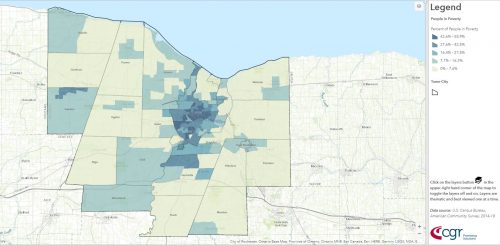 We know the pandemic is impacting people and communities unequally. What does that look like in Rochester?
We know the pandemic is impacting people and communities unequally. What does that look like in Rochester?
Based on an inquiry from the United Way of Greater Rochester and our community’s Systems Integration initiative, CGR mapped Census data correlated with economic risk linked to the outbreak. Cornell University’s Industrial and Labor Relations School developed and analyzed estimates of households and communities most at risk of job loss. The authors found the people and communities most vulnerable based on their occupation are the same we already know to be struggling – neighborhoods that are low-income, have a high share of renters rather than homeowners, and higher shares of residents of color.
In our community, as in many others, those are mostly urban neighborhoods. As shown in our mapping tool, Census tracts with the highest estimated poverty rates, 50% or more, are clustered in the northeast and southwest areas of the City of Rochester. The map reveals that poverty is not limited to the City – a few census tracts in Henrietta have estimated poverty levels of 30-40%, for example – but the highest concentrations are in areas of the City.
Many of the same areas are dominated by renters, with 75% or more of housing units renter-occupied, and have high proportions of African American and Hispanic residents, as shown by toggling through the different map layers.
Another view of neighborhood vulnerability is offered by the Urban Institute, which has put together some similar and different datasets to map estimates of low-income job losses due to the pandemic.
We know that job security, food, housing, transportation and child care are concerns in our community based on feedback gathered by the Rochester-Monroe Anti-Poverty Initiative. Local leaders are working to ensure that resources are accessible to the communities that most need them, an effort our maps will hopefully inform.
Policymakers have taken steps to protect at-risk populations, including New York State’s moratorium on evictions and the federal government’s increased eligibility and unemployment payments for those who lose their jobs or are furloughed. But those protections are set to expire in the coming months.
As some regions of New York begin to reopen parts of their economies, including the Finger Lakes beginning later this week, we may see signs of improvement. But many low-income industries, including food service and hotel accommodations, aren’t set to open until later phases of reopening.
The pandemic has thrown our country and our community’s long-standing inequities into stark relief and demands that we devote more effort to expanding opportunity and safeguarding the well-being of all residents.
As the outbreak continues to threaten residents and community stability, CGR is prioritizing work to help local governments, nonprofits, funders and service providers respond and plan for the future. If we can help you, please contact us at info@cgr.org.
